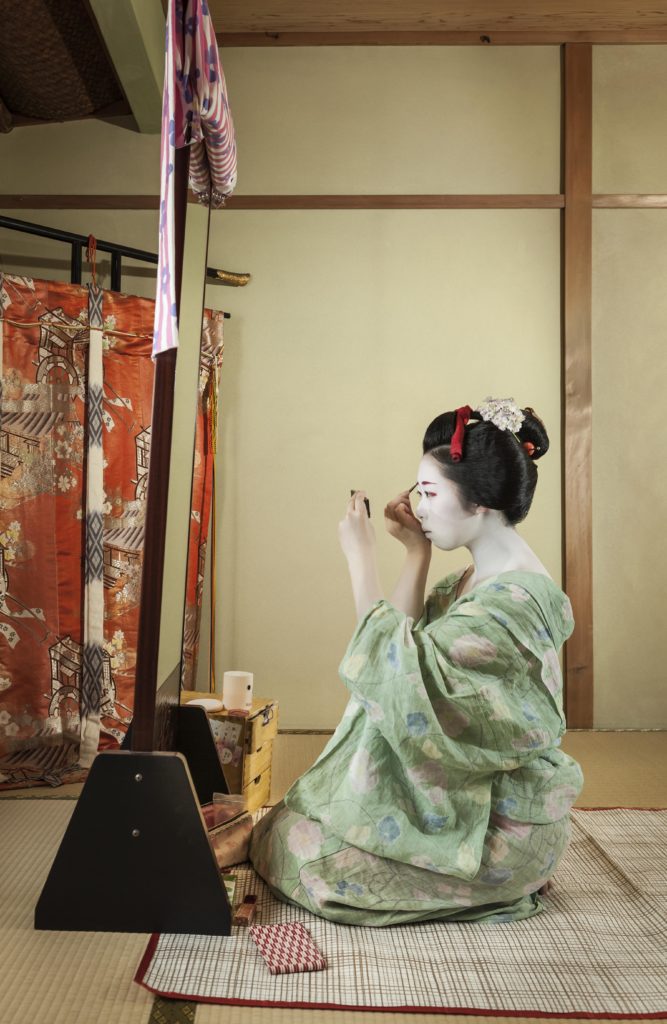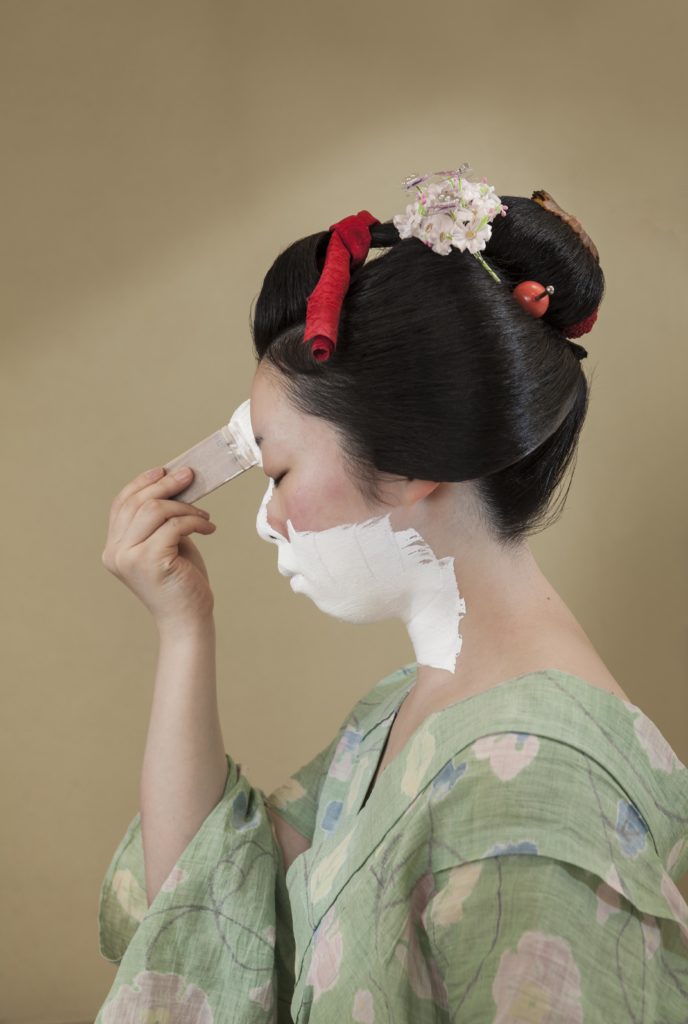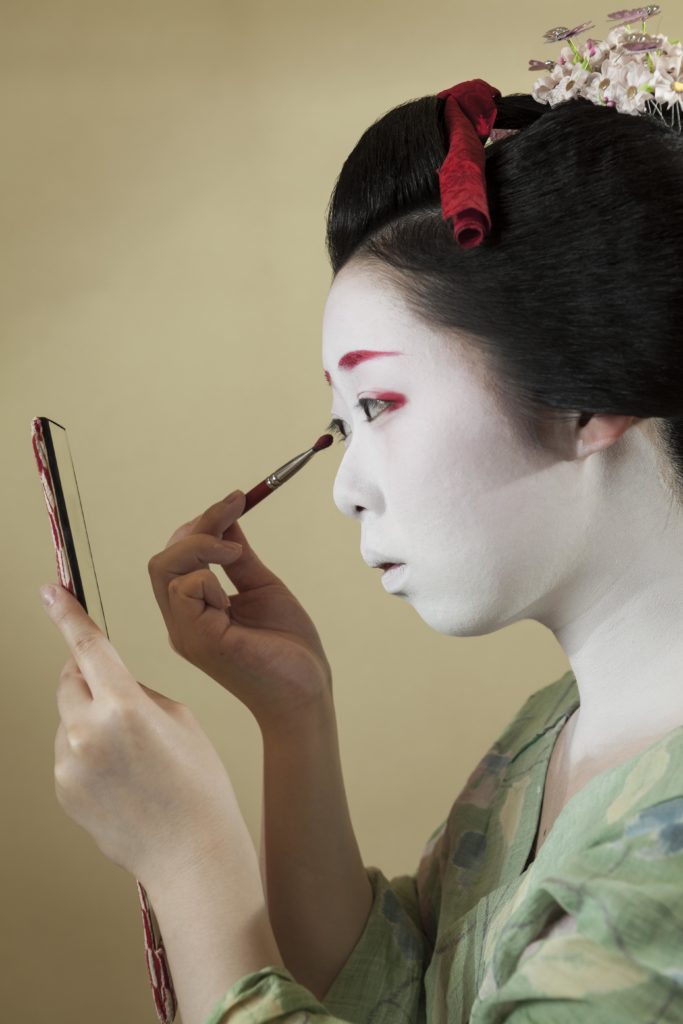
One of the most significant parts of a geisha’s appearance is a thick white makeup on the face and neck. Oshiroi (白粉, lit. “white powder”) is also essential for kabuki actors, nihonbuyo, jiutamai dancers, and other performing artists. While geisha wear this makeup for their everyday engagements, oshiroi is normally considered as a conception used strictly on stage. Performing arts in Japan happen to be connected with creating an individual character, a brand new role of the artist. It’s visible especially among geisha and kabuki actors—they adopt new first names and surnames upon entering the world of theatre and dance. Accordingly, they create a brand new character—connected to the pseudonym—with oshiroi. A dancer’s face has to be still as a mask—and oshiroi allows this kind of an emotional retreat. Sensations are locked in the dancer’s body motion and eyes expression. There’s no place for smirks, tears, nor frowns.

Geiko and maiko of Kyoto need to apply oshiroi almost every day and pair this distinctive look with trailing stage kimono (引きずり hikizuri/susohiki). The whole face and neck is covered in this white thick paste, but for on-stage performances even hands and calfs need to be painted, too. Sometimes maiko, coming back home from the performances, wear gloves and sheer leggings to protect the kimono and accessories from stains.

During the application process of oshiroi, female dancers wear light cotton yukata—instead of any other kimono—and tie it briefly with simple koshihimo. Powders, liquids, and rouges could easily ruin a silk garment, but cotton yukata can be washed without any additional effort.

Geiko, actors, and professional dancers start the whole process with putting on a habutai—a protective cap that goes underneath the katsura (read more about it here). The cap is coated with grease on the front part first and then stuck to a forehead with a paper adhesive tape. The front part is painted with oshiroi and then covered by katsura. Habutai is reusable and can be rinsed with warm water to remove the white pigment.

Maiko style their own hair in elaborate nihongami, so they start directly with application of a primer (abura). Its texture is fat and greasy and melts in warm hands. It’s applied by rubbing a small amount of abura onto the bare skin. This method is arduous and time-consuming—abura is more like a wax, then standard foundation base. In spite of its heavy structure, it actually works pretty well for all skin types—pores get invisible, face gets smooth, and the wax itself has a healing effect for imperfections. Abura creates a protective shield against heavy oshiroi pigment and even prevents skin from sweating during a performance or an exceptionally warm day. Applied every day, however, may increase skin problems because it clogs the pores and prevents the skin from “breathing”.

When the whole face and neck area is already concealed with abura, the artist needs to lay down the eyebrows. It’s a popular technique among film and theatre makeup artists, drag queens, and stage performers. Nevertheless, geiko and traditional artists do not use a cheap school glue stick for this step—they rely on a special adhesive (tsubushi) that looks like a hard pinky-brown plasticine. Likewise abura, tsubushi needs to be melted with warm fingers and only then it can be rubbed onto the brows. Some of the geisha prefer to shave half of their eyebrows, so it’s easier to draw a brand new silhouette.

A face is now ready for the oshiroi. Accordingly to its name, it comes in a powder form and has to be prepared separately each time. The snow-white powder is mixed with water to get a thick paint-like substance. It’s very important to provide the best quality of water for this step. Tap water is usually too harsh, so artists tend to choose their favourite bottled water. The powder itself is made of talc, kaolinite (strongly comedogenic ingredients), magnesium carbonate, corn starch, and zinc oxide (great for acne-prone skin).

Wet oshiroi is put onto the skin with flat brushes at the parts that need to be shaped perfectly (i.e., prongs on the neck or close to the ears), while the rest of the painted area is blended by patting the skin with a big makeup sponge. This method helps the cosmetics to sit better on the primer.

Maiko and geiko finish their makeup with two (衿足 eri ashi; for everyday look) or three (三本足 sanbonashi; for formal attire) prongs on their napes—they paint them manually or with the help of a stencil. This beauty mark enhances a neck silhouette and a base of a particular nihongami.

Whitened face creates an illusion of a plain canvas—thus it makes a flawless foundation for a contouring procedure. Pink rouge (which comes in a form of powder and has to be mixed with water, too) is applied not only on the cheeks, but also on the forehead, nose, eyelids, and any other area that needs to be sculpted and contoured. The basic rule of contouring says that highlighted parts (pure white in this case) bring out the features we want to embellish, and darker makeup helps to hide the “unwanted” parts. In general, newly painted eyebrows tend to be placed higher (that’s why the tsubushi wax lays the natural eyebrows down) and nose is shaped with two straight lines to make it appear slimmer and longer. Going further, rosy cheeks disguise a face that is too round. Because of that, oshiroi makeup is never fully white; sometimes even the whole face is covered in milky pink blush. This makeup trick is used widely by junior maiko who like to emphasize their cute appearance with extended amount of blush.

The oshiroi makeup is finished with sumi—colouring liners in red and black. A red eyeshadow is placed in the outer corners of the eyes and then, it’s adorned with a solid black eyeliner. Lips get enriched with crimson red lipstick (also water-based and applied with a brush) in a way that, generally, makes them appear smaller and plumpy. First-year maiko are allowed to apply red tint only on their lower lip, as it’s a symbol of their minor rank. However, this rule is useless in Pontocho district—all maiko debut with both lips already painted. In other hanamachi some of the junior maiko happen to be upset about this makeup rule (they say that it interferes the proportions and the whole face looks odd) and beg their okasan to let them colour the full lips earlier. I personally find this “incomplete” look very appealing and classic, as it reminds me of vintage bijin portraits.

At the end of the day (or, actually, late at night) maiko and geiko wipe off their stage makeup with a special oily solution. It looks similar to a still coconut oil and dissolves the oshiroi along with the heavy primer. Afterwards, the oil has to be rinsed off with a water—otherwise it may cause a skin breakout if it’s left out to clog the pores.

Oshiroi creates a mask-like illusion and helps the artists to impersonate the character connected with their stage names. For geisha, the adopted character stays with them all the time, even without the mask makeup on. After a while though, it may get even harder and harder to distinguish an illusion from a real self.

Photos of maiko Kikuyae from the Hanafusa okiya in Miyagawacho – by Paul van der Veer
https://www.facebook.com/paulvanderveer
